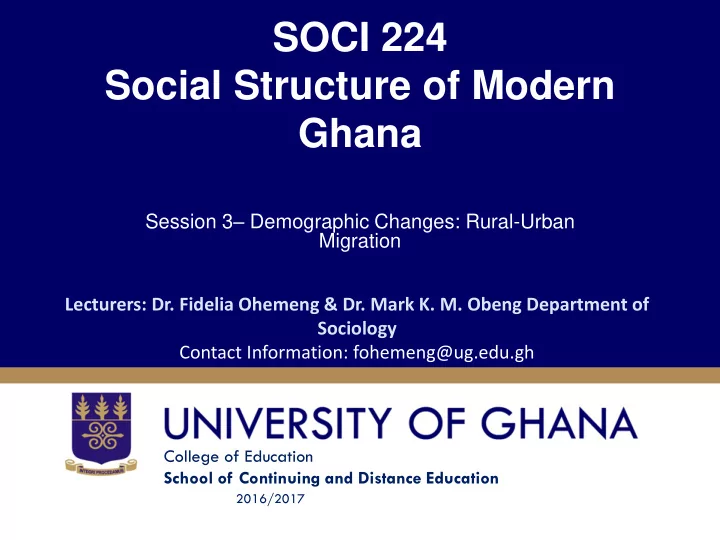

SOCI 224 Social Structure of Modern Ghana Session 3 – Demographic Changes: Rural-Urban Migration Lecturers: Dr. Fidelia Ohemeng & Dr. Mark K. M. Obeng Department of Sociology Contact Information: fohemeng@ug.edu.gh College of Education School of Continuing and Distance Education 2016/2017
Session Overview • A lot of changes have occurred in Ghana’s population. The population has grown substantially and a lot more people are moving to the urban areas. The session examines the trends in Ghana’s demography. It also identifies the causes for the movement of people from the urban areas to the rural as well as its implications for the society. Suggestions to mitigate rural-urban migration are also examined. Slide 2
Session Outline The key topics to be covered in the session are as follows: • the changes that have occurred in Ghana’s population structure • the factors that contribute to rural-urban migration • the consequences of rural-urban migration for both the rural and urban social structures • ways to mitigate rural-urban migration Slide 3
Reading List • Abotchie, C. (2014). Social Change in Ghana. Accra: Hans Publications. Chapter 2 • Nukunya, G. (2014). Tradition and Change in Ghana: an Introduction to Sociology. Accra: Ghana Universities Press. Chapter 11 • 2010 Ghana Population and Housing Census • Breakdown of Metropolitan, Municipal and District Assembly Slide 4
Topic One CHANGES IN GHANA'S DEMOGRAPHY Slide 5
Changes in Ghana’s Demography • Available data shows Ghana’s Population: 1948 -2010 that Ghana’s 30 population has grown 24.7 25 substantially 18.9 20 • Five censuses have been conducted since 15 12.3 independence 10 8.6 6.7 4.1 5 0 1948 1960 1970 1984 2000 2010
Population by Region and Sex, 2010 • REGION TOTAL MALE FEMALE • All Regions 24,658,823 12,024,845 12,633,978 • Western 2,376,021 1,187,774 1,188,247 • Central 2,201,863 1,050,112 1,151,751 • Greater Accra 4,010,054 1,938,225 2,071,829 • Volta 2,118,252 1,019,398 1,098,854 • Eastern 2,633,154 1,290,539 1,342,615 • Ashanti 4,780,380 2,316,052 2,464,328 • Brong Ahafo 2,310,983 1,145,271 1,165,712 • Northern 2,479,461 1,229,887 1,249,574 • Upper East 1,046,545 506,405 540,140 • Upper West 702,110 341,182 360,928
Age Distribution (2010) Age Total Male Female 0-14 9,450,398 4,798,944 4,651,454 15-64 14,040,893 6,727,948 7,312,945 65+ 1,167,532 497,953 669,579 Adult 13,632,299 6,431,820 7,200,479 population (18+) Dependent 10,617,930 5,296,897 5,321,033 population (<15 + 65+)
Major Ethnic Groups in Ghana (2010)
Growth Rate • The growth rate of every country is Year Annual Growth determined by fertility rate % 1960 na rate, mortality rate and 1970 2.4 migration 1984 2.6 • Fertility rate (GDHS, 2014) 2000 2.7 Year Rate 2010 2.5 1988 6.4 1998 4.4 2003 4.4 2008 4.0 2010 4.2
Life Expectancy: 1960-2010 Year Male female 1960 38 43 1970 45 48 1984 50 54 2000 55 60 2010 60 63
Causes of Demographic Change • Ghana’s population has grown substantially due to: – Improvement in Medical Science • On the other hand fertility rate has reduced due to: – Improvement in female education – Economic advancement
Topic Two RURAL-URBAN MIGRATION Slide 13
National Urban-Rural Distribution: 1960-2010 • Ghana’s urban population has increased since independence. About half of Ghana’s population live in urban areas • Below is the trend in urban population: 1960: 23% 1970: 29% 1984: 32% 2000: 44% 2010: 51%
Regional Rural-Urban Distribution- 2010 Slide 15
Population of Six Major Cities in Ghana Year 1970 1984 2000 2010 City/Town Accra 624,091 969,195 1,658,937 2,070,463 Kumasi 346,336 496,628 1,170,270 2,035,064 Tamale 83,653 135,952 202,317 371,351 Takoradi 80,309 117,989 175,436 311,206 Sekondi 63,673 70,214 114,157 228,342 Ashaiman 24,549 50,918 150,312 190,972
Factors That Influence Rural-Urban Migration • Push /centrifugal – Economic factors: few employment opportunities – Social factors: escape from traditions and customs – Lack of social amenities and infrastructure – Lack of entertainment facilities
Rural -Urban Migration • Pull factors/centripetal – Economic: perceived availability of jobs in urban areas – Social factor: less rigid customs; greater anonymity – Cultural attractions: availability of social amenities such as higher education, lights, hospitals
Topic Three IMPACT OF RURAL-URBAN MIGRATION Slide 19
Impact on rural areas • Rural economy is affected since able-bodied young men and women migrate to urban centers • Religiosity is affected • The family is affected • Traditional political authority weakens
Impact on urban areas • Urban poverty • Insecurity in urban areas as crime increases • High unemployment and underemployment • Kinship ties giving way to associational ties • Pressure on social amenities
Impact on urban areas
Topic Four STEMMING THE TIDE Slide 23
Breaking the tide • Establishment of agro-based industries • Investment in rural economy in terms of loans • Review land tenure system • Subsidization of agricultural imputes such as fertilizers, tools • Good roads to aid marketing of farm produce and markets to sell produce
Recommend
More recommend